Chapter 4
Other Earth Sciences
Rocks and soil are part of the makeup of our planet Earth, in addition to water on the surface and under the ground. All of that is engulfed by a vast atmosphere that makes it possible for life to exist.
The sciences related to Earth surround us. You’ve always had a direct experience of them when you’ve gone to a swimming pool and played with a ball and watched it float in the water. And every time you’ve tuned in to the evening news to hear the forecast, you’ve heard the science of our planet splashed all over that forecast.
This chapter will help you and your child explore some important concepts pertaining to earth science that affect your everyday life. It will also feature some of the professions related to this fascinating area of science.
ACTIVITY: North versus South Pole
The terms north pole and south pole usually make people think of the geographic regions known as the North Pole and the South Pole. There are, however, two other kinds of north and south poles. Those are the north magnetic and the south magnetic poles. And when referring to our planet, we should be specific about whether we’re referring to the north geographic or the north magnetic pole.
STEM Q&A
What are the geographic north and south poles?
The north geographic pole lies in the Arctic and is the most northern point on Earth. The south geographic pole lies in the Antarctic and is Earth’s most southern point. Planet Earth rotates about itself once every day. It spins about an imaginary axis that connects the north and south geographic poles.
How do magnetic poles behave near each other? When you use a compass needle to find north, does the magnetized compass needle point in the direction of Earth’s north magnetic or the south magnetic pole? And how are the earth’s magnetic poles related to the earth’s geographic poles?
Materials Needed:
- 1 sewing needle
- 2 flat metal-head straight sewing pins
- Strong bar magnet
- Compass
Procedure:
- If the bar magnet sides are not labeled N (for North) and S (for South), then have your child use the compass needle to identify N and S. Have her bring one side of the bar magnet near the side of the compass needle that’s labeled N (it is usually the side that’s colored in red). If the N side of the compass needle is attracted to the side of the magnet she brought near it, then that side of the magnet is S (South). Tell your child to make a note of which side of the magnet is S.
- Ask your child to sit at a table and to place one of the straight pins to her left and the other one to her right.
- Tell your child to hold the head of the needle in one hand.
- Now have her hold the bar magnet in the other hand.
- Ask your child to stroke the needle, from head to tip, with the north side of the bar magnet. Have her do this repeatedly in the same direction at a steady, medium speed about 5–10 times, then set the needle somewhere in front of her, away from the two pins. While holding the head of the pin to her left, ask your child to stroke the pin, from head to tip, in the same fashion with the north side of the magnet, then place the pin back on the table to her left.
- Now tell your child to pick up the needle by its head, and bring its tip very close to the tip of the left pin (which is lying on the table). What happens? Does the tip of the needle repel or attract the tip of the left pin? You should observe the needle’s tip and the left pin’s tip repelling each other, as illustrated in the following diagram. This is because both needle and left pin were magnetized from head to tip by the same north magnetic pole. This makes the needle and left pin magnetized identically. In other words, if the tip of the needle became magnetized north, the tip of the left pin was also magnetized north.
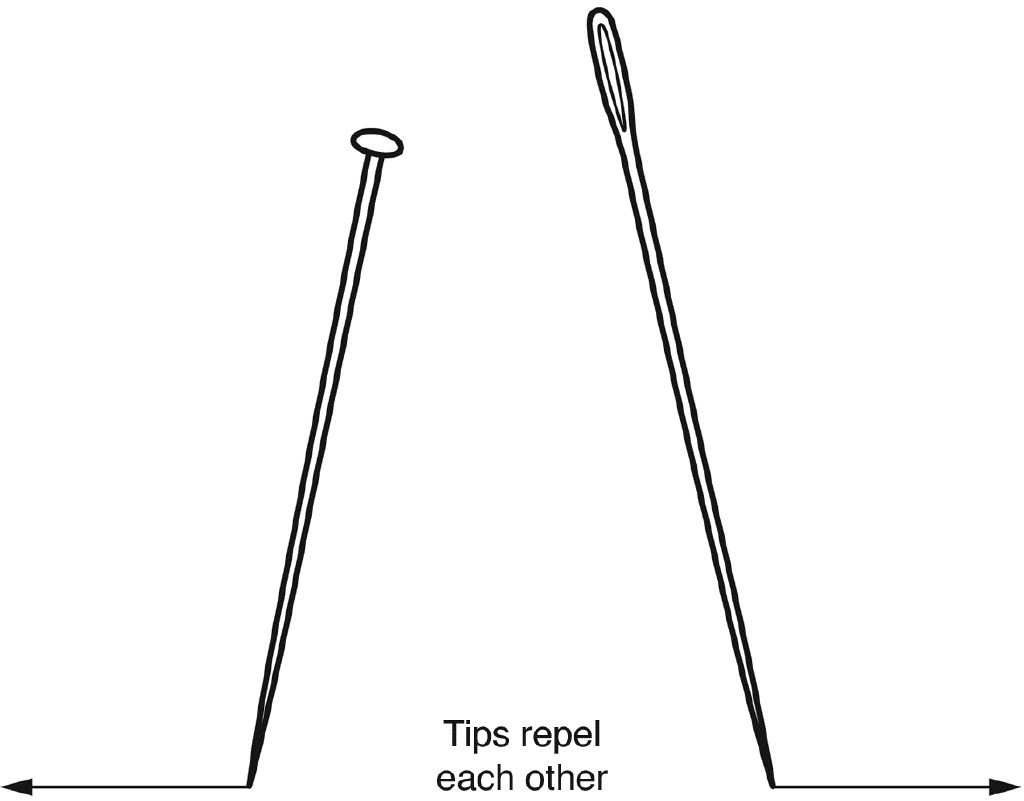
- Now have your child do the following. While holding its head, ask your child to now stroke the right pin, from head to tip, with the south side of the magnet in the same fashion as before. Have her place the pin back on the table to her right.
- Now have your child pick up the needle by its head, and this time bring its tip very close to the head of the right pin (which is lying on the table). What happens? Does the tip of the needle repel or attract the head of the right pin?
You should observe the needle’s tip and the right pin’s head repelling each other, as illustrated in the following diagram. This is because the needle was magnetized by the north magnetic pole (making its tip magnetized north) while the right pin was magnetized by the south magnetic pole (making its tip magnetized south). Note that when one side of the needle becomes magnetized north (for example, its tip), then its head automatically becomes magnetized south. The same is true for the pin: When its tip is magnetized north, then its head is automatically magnetized south and vice versa. That’s just how nature works!
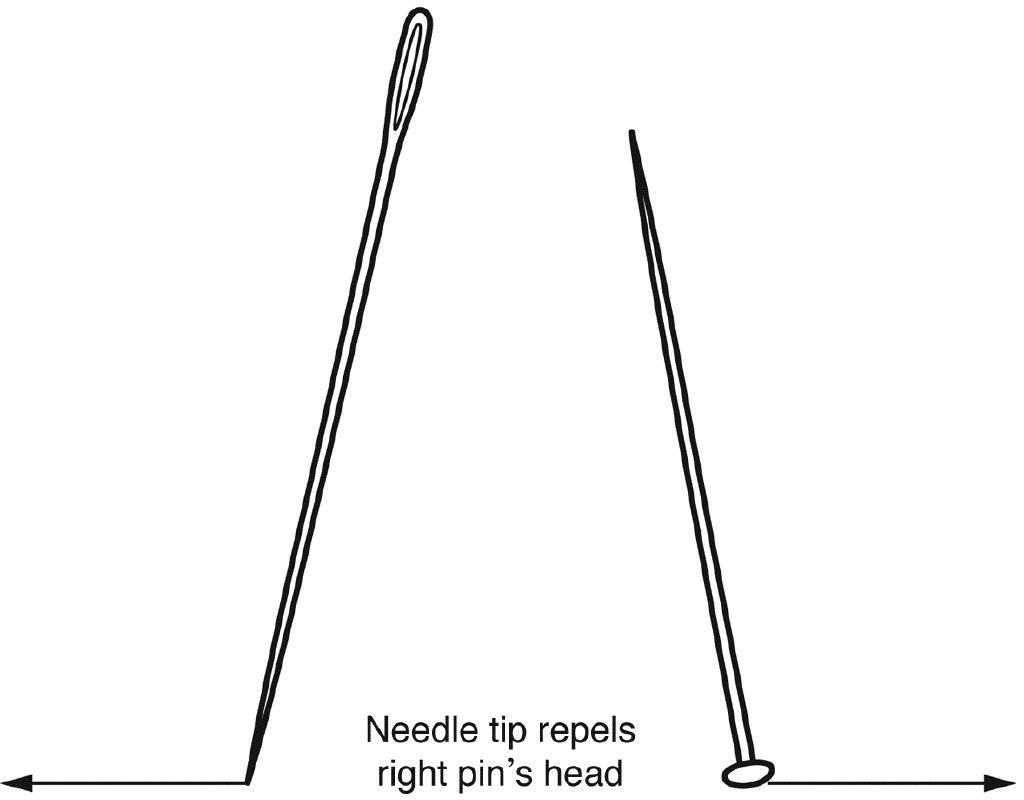
Ask your child what was different between the left and right pins. Remind your child that the left pin’s tip was magnetized north. What was different about the way she magnetized the right pin?
Your child probably remembered that when magnetizing the right pin, the magnet was flipped, and therefore the left and right pins were magnetized by opposite magnetic poles. This would cause the poles on the right needle to be the reverse of the poles on the left needle, as illustrated in the following diagram.
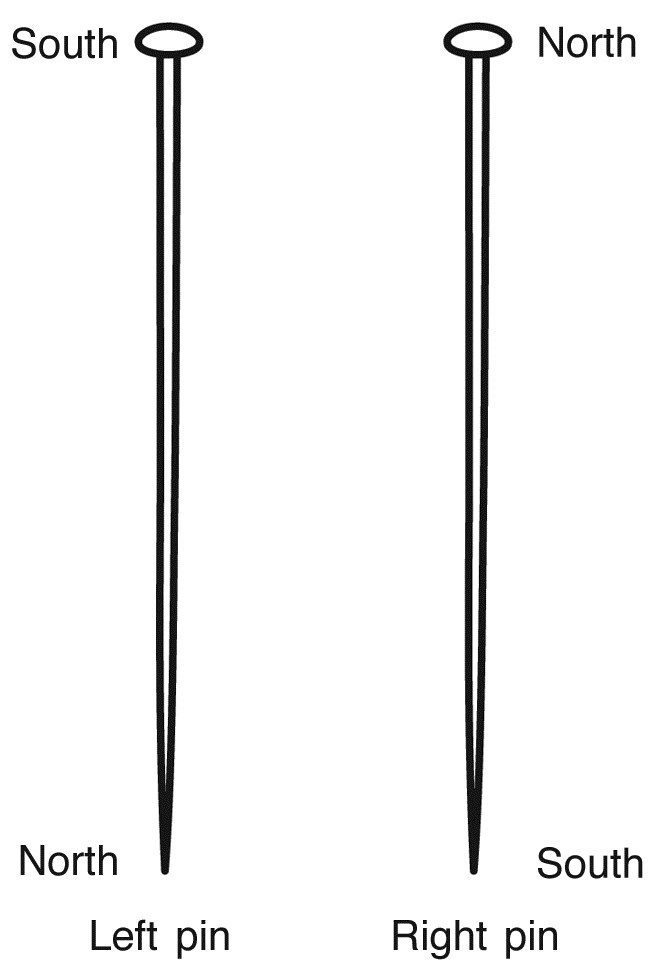
Now ask your child this question: Why did the left pin’s tip repel the needle’s tip, while the right pin’s head did the repelling?
Your child most likely found out by now that magnetic poles that are alike repel. She most likely remembered that the needle’s tip was magnetized north, as shown in the diagram. That’s why the needle’s north tip repelled the left pin’s tip (which was also magnetized north). The same needle’s tip later repelled the right pin’s head (also magnetized north).
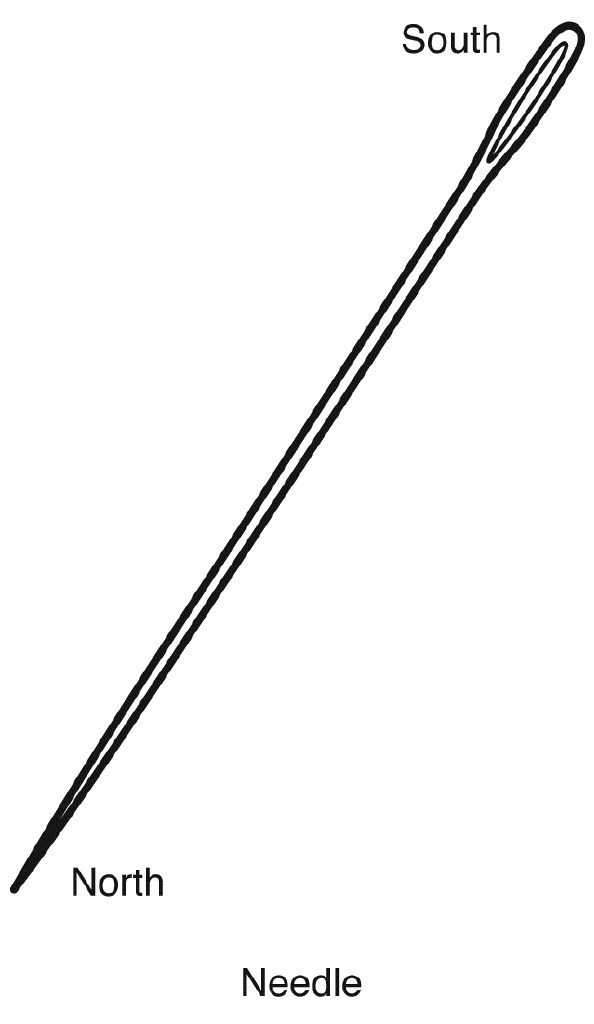
If magnetic poles that are alike repel, what about magnetic poles that are opposite? Ask your child what she thinks. If her answer is that they attract, she’s correct. This means a magnetic north pole attracts a magnetic south pole, and vice versa.
STEM Q&A
Where are the north and south magnetic poles located?
Earth’s north and south magnetic poles are not permanent, as the geographic poles are. The north-south magnetic poles on planet Earth flip every few hundred thousand years, making the north magnetic pole a south one, and vice versa. Scientists discovered this when studying the ocean floor of the Mid-Atlantic Ridge, which has stored this pattern over millions of years.
People use a compass to find the geographic north direction. It’s an especially handy tool when hiking in the wilderness. A compass needle is very much like the sewing needle your child magnetized. The red side of the compass needle is magnetized north, while the other side of the needle is magnetized south. So here’s an interesting question to ask your child: In which geographic direction would Earth’s south magnetic pole be? Is it in the direction of the geographic north pole, or the geographic south pole? Remind her that a magnetic north is attracted to a magnetic south.
Since the magnetic north pole of the compass needle points toward the geographic north, then it must have been attracted by a magnetic south pole, therefore the geographic north pole must be the magnetic south pole.
STEM Career Choices
Geologist
A geologist studies all the materials that make up Earth. This includes solids, liquids, and the surface layers as well as the interior of Earth. They study volcanoes, earthquakes, landslides, faults, and floods. This gives them the ability to survey land for safe building. Geologists are concerned with long-term changes in the land and in the climate.
Geologists are involved in many other types of investigations. Some geologists survey land for natural resources such as water, oil, and natural gas, as well as examine methods to extract them. Based on their observations of rocks and fossils, a geologist can describe the geological processes Earth underwent for the past several million years.
ACTIVITY: Pressure, Temperature, and the Weather
If you’ve ever been in a crowd of people trying to exit a place very quickly (such as when there is an emergency), you know about pressure. You might also know that it feels hotter when there are so many people pushing through a door or a gate. This is exactly how the air molecules “feel” when the pressure is high: The heat is turned on (the temperature goes up). Pressure is the amount of force applied to a surface area.
But what happens when the pressure is low? Does the temperature go down?
Materials Needed:
- Balloons (have several handy in case one pops)
- Freezer
- Video device to document the event (optional)
Procedure:
- Ask your child to inflate a balloon using his own breath. Make sure he inflates it to a point where the balloon is stretched to the limit without popping. (You might need to do this more than once if the balloon pops.)
- Place the balloon on an empty rack in the freezer for at least 24 hours.
- Remove the balloon from the freezer. If you are making a video, start recording the balloon before you remove it from the freezer. What do you observe?
Does the balloon look different than when you first placed it in the freezer? Does it look smaller and wrinkly? What begins to happen to it the instant you pull it out of the freezer and into the warmer environment of your kitchen? Does the balloon begin to expand back to its previous size?
If you’ve recorded the entire event, you can replay that video rather than place the balloon back in the freezer for another 24 hours to see the effect again.
In order to understand the relationship between temperature and pressure, you need to zoom down to the level of the air molecules inside the balloon.
STEM Words to Know
molecules
A molecule is made of two or more atoms (the smallest building blocks in nature). For example, an oxygen molecule is made of two oxygen atoms that are bonded together. When you breathe in oxygen, you are breathing oxygen molecules. A water molecule is made of one oxygen atom bonded with two hydrogen atoms.
You can think of the air molecules as little balls constantly moving and bouncing off each other. They also bounce off the inside wall of the balloon. The arrows in the drawing show the motion of the air molecules. When those molecules bounce off the walls of the balloon, they apply pressure to it.
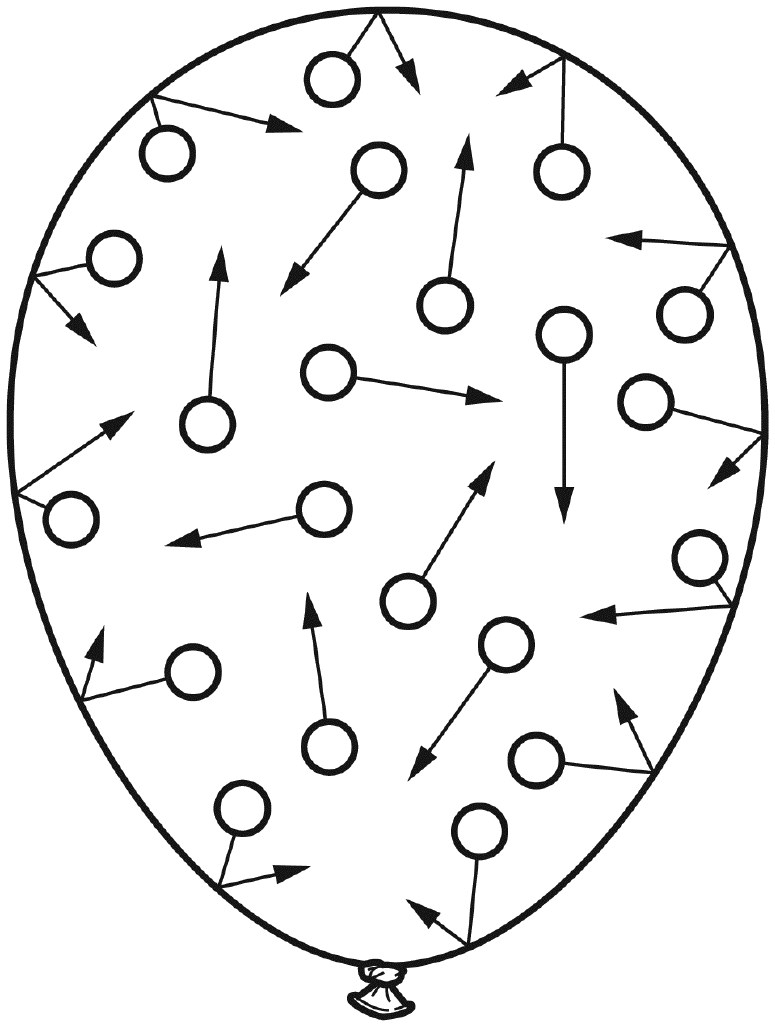
What does it mean to apply pressure? When you press against a surface, you apply pressure. For example, if you stand on a trampoline, you’re applying pressure (or force) to the surface of the trampoline. You can see the effect of that pressure on the trampoline because its surface stretches down.
Similarly, the air molecules press against the balloon surface as they bounce off it. This pressure makes the balloon stretch out.
STEM Career Choices
Meteorologist
Meteorology is a science that focuses on Earth’s atmosphere. A meteorologist is someone who observes Earth’s atmospheric phenomena, then analyzes and explains these phenomena using scientific methods and principles. A meteorologist can also forecast effects in Earth’s atmosphere and how these effects relate to life on our planet. Meteorologists are mostly known for predicting the weather and climate, and its impact on our lives.
A meteorologist can hold a variety of different jobs: the “weather forecaster,” giving the daily weather forecast; an atmospheric researcher; a college professor; or an employee in a private meteorological company or with the government.
Once inside the freezer, the air inside the balloon cools down. When the air is cooler, its molecules don’t move around and bounce as much. They basically slow down and get closer to one another. They’re cold! In a way, they’re like you when you’re cold: You just want to move less and cuddle close to someone. Notice how the arrows in the drawing get smaller, showing a slower motion of the air molecules. And when they slow down, they’re not bouncing as hard off each other and off the balloon surface. They don’t push as hard. This makes the balloon less inflated.
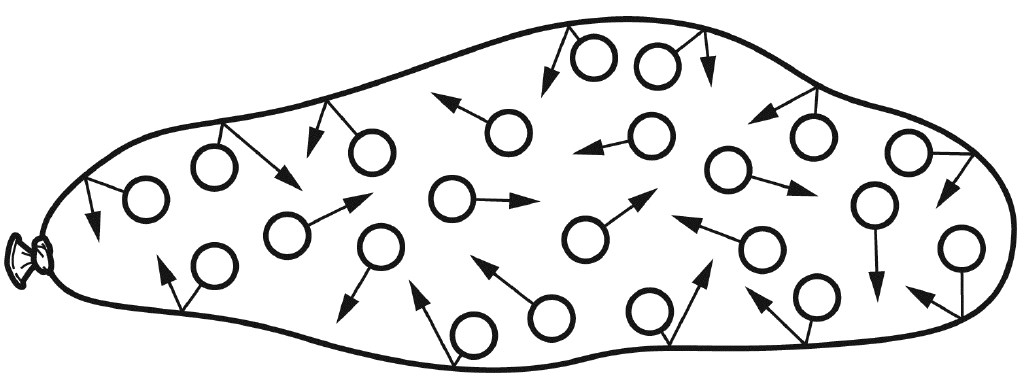
This means that when the temperature of the air goes down, so does its pressure.
Do you think this is similar to how the air behaves in the weather? Absolutely. When cooler air moves in, it’s usually accompanied by low pressure. Listen closely to what the forecaster says the next time you hear the weather forecast.
ACTIVITY: Why Do Some Things Float?
When you throw a rock into the water, it sinks. But huge, heavy objects like ships float in water as they travel the oceans. Why is that?
It’s all about buoyancy. What is buoyancy and what factors affect it?
STEM Q&A
Q: Who was the first scientist to understand buoyancy?
A: Archimedes was a Greek scientist who lived in the third century B.C. He was the first scientist to understand buoyancy and how to apply it to real-life dilemmas that required solutions. For example, using his understanding of buoyancy, Archimedes was able to detect that the king’s crown was not made of pure gold, but was mixed with a cheaper metal such as silver.
When an object is placed in a fluid such as water, the object is pushed up by a force from within the water called the buoyancy force. There’s more than one factor that makes the buoyancy force larger or smaller. One such factor you can investigate is the surface area with which the object touches the fluid. The following experiment will help your child specifically explore the relationship between the buoyancy force and the surface area of an object placed in water.
Materials Needed:
- Aluminum foil roll
- Big plastic tub 14" (L) × 14" (W) × 6" (H)
- Vise grip
- Pliers
- Scissors
Procedure:
- Using scissors, cut 2 sheets of aluminum foil that are 12" × 7".
- Assist your child in filling the tub about 3⁄4 full with water.
- Give your child 1 of the aluminum foil sheets. Carefully help her place the flat sheet on top of the water. Take caution not to bend the sheet so that you don’t let any water float on top of the sheet. What do you both observe?
- Now let your child crumple the second aluminum sheet into the tiniest ball she can make. Then, using the vise grip and the pliers, assist her in squeezing the aluminum foil ball down to an even tinier ball. Keep squeezing it until it becomes a small ball with a diameter of no more than 1⁄2".
- Place the ball of crumpled aluminum on top of the water. What do you observe?
Did the aluminum sheet float? What about the aluminum ball? Did it sink? Why do you suppose they behaved differently even though they’re made of the same material (aluminum foil)? Ask your child what the difference is between the flat and the crumpled aluminum foil. Remind her that they were identical to start with; they were the same size and are made of the same stuff. Does she think it matters that the flat sheet has a larger surface than the crumpled one?
If she guesses yes to that last question, she’s absolutely right. The crumpled aluminum ball sinks straight to the bottom of the tub. The flat sheet, with its larger surface area, floats on top of the water.
Take a few moments to consider and discuss how the water influences the flat sheet as it floats on top of it. The water pushes up on every part of the sheet’s surface. This is the buoyancy force. The larger the sheet’s surface the water can push against, the more distributed the force is over that surface (as shown in the picture) and the larger the buoyancy force.
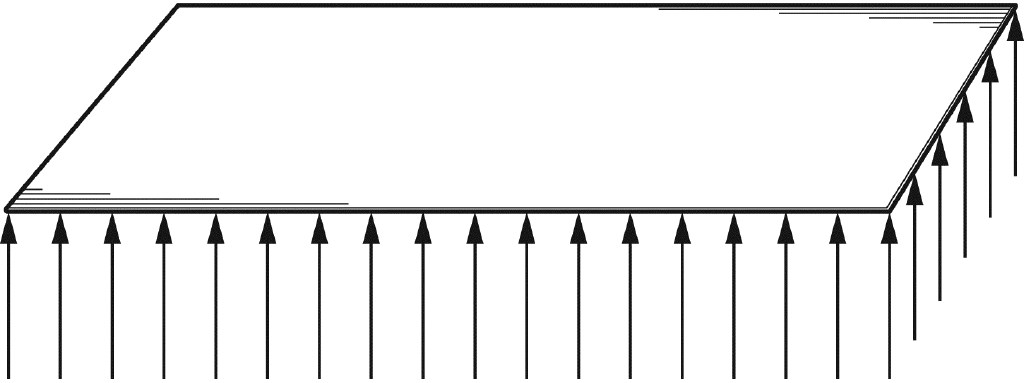
When the aluminum foil is crumpled to the size of a small ball, the water can only push up against a tiny, tiny surface area. The smaller the surface the water can push against, the smaller the buoyancy force.
As long as the upward buoyancy force on an object is equal to the weight of the object, it will float. That’s exactly why ships have a large surface area. The buoyancy force pushing the ship up—so it can stay at the surface—must be just as big as the weight of the ship, or else it would sink.
STEM Career Choices
Hydrologist
Hydrologists study the water on our planet, how it moves across the surface of Earth, its quality, and its availability as a resource. They find solutions to issues concerning water supply to cities and farms. When there are problems with water pollution, hydrologists are involved in cleaning up and preventing future pollution to such water resources.
Hydrologists are often found in the field collecting water samples. They perform analyses on those samples in order to check the quality of the water. In addition to testing water quality, hydrologists engage in a variety of other tasks, such as working on flood control near rivers and designing proper underground disposal of hazardous waste.
ACTIVITY: Balloons, Spoons, and Density
When you throw a penny in the water, it sinks. But when you throw in a twig, it floats. Even if the wood is much larger than the penny—say a log—the wooden log still floats. Why is that?
It’s all about the density of the material you’re using. Density is a measure of how much mass (matter) is compacted into a specific volume of the material. Since mass is measured in grams (g) and volume is measured in cubic centimeters (cm3), density is measured in grams per cubic centimeter (g/cm3).
One way you might test the density of materials is by squeezing them. If one material takes more effort to compress than another, it’s denser. For example, a metal toolbox is far denser than a loaf of bread.
Is there a more scientific way to test the density of material rather than trying to squish it? Here’s the bottom line for the method of measuring density: When you attempt to place an object in a cup full of water, depending on the object’s density, it’ll spill more or less water. This phenomenon happens because everything occupies a certain amount of space. The water in the cup occupies the entire space inside the cup. If you attempt to add more things into that space, some of the water has to spill, or become displaced.
You’ll be measuring mass in this activity. Mass is a measure of how much matter is in an object. Mass is measured in grams, the abbreviation for which is g.
Materials Needed:
- Several different-sized rocks (a size that fits in your fist, some slightly smaller, some slightly larger)
- Child’s rubber duck
- Electronic kitchen scale (with a “grams” setting available)
- Bucket
- Plastic tub the bucket can easily fit into
- 2 measuring containers or glasses
- Water hose connected to a faucet
- Pencil and paper
Procedure:
- Ask your child to place the kitchen scale on a flat surface, then turn it on. Make sure the scale is set to the “grams” setting. Make sure to tare (reset to zero) the scale properly.
- Have your child place the rubber duck onto the scale. Ask her to record, in grams, the mass of the duck on her paper—for example, 25 g.
- Have your child place each of the rocks on the scale one by one, measuring and recording the mass of each one of them, also in grams.
- Ask your child to choose the rock that has a mass close to that of the rubber duck. Have her set the other rocks aside so she doesn’t accidentally use them.
- Have your child place the bucket into the plastic tub, and place the tub on the ground. Using the water hose, your child can now fill the bucket with water to the very top. You can assist her in filling the bucket so that no water spills out of it. It is important that the water reaches the very top of the bucket, to the point just before it spills.
- Ask your child to drop the chosen rock into the bucket. Ask her to observe whether the water spills out of the bucket. Assist your child in emptying the spilled water from the tub into one of the measuring containers.
- Pull the rock out and place the bucket back into the tub, then refill the bucket to the very top without overfilling it.
- Have your child take the rubber duck and submerge it totally into the bucket by pushing it down with her hand just far enough to where the duck’s head is just below the surface of the water. Ask her to observe whether the water spills out of the bucket into the tub. Empty the spilled water from the tub into one of the measuring containers.
Was there water that spilled out when the rock went into the bucket? What about when the rubber duck was submerged? Check the two water levels in the two measuring containers. Was it the same amount of water in both cases? Which one displaced more water out of the bucket, the rock or rubber duck?
Your child most likely figured out that the rubber duck displaces far more water than the rock. The rubber duck has a mass similar to a rock, so it must be something else about the rubber duck that made more water spill. Ask your child what she thinks is different about the rubber duck than the rock. Is it perhaps the material it is made of? Is it possibly its size (volume)?
If she guessed yes to either of those two questions, she guessed right. Discuss with your child the answer to the first question. The duck is made of rubber, but the rock is made of a material called silicates. Rubber isn’t as dense as rock; the density of rock is much greater than that of rubber. The greater the density, the more matter is compacted into the object. The density of the rubber in the duck is about 0.5 g/cm3, while the density of rock is well over 2 g/cm3.
Now discuss with your child the answer to the second question, the one pertaining to the size of the two objects. Because the densities of rubber and rock are different, the sizes (volumes) of the rubber duck and the rock have to be much different in order for their masses to be the same. Recall that you had your child pick the rock that measured closest in mass to the duck, using the kitchen scale. The greater the density of an object is, the smaller its size. The rock has a much greater density; that’s why its size is smaller than the rubber duck.
Since the size of the duck is larger than the rock, it would need to displace more water if it’s going to sit in the space inside the bucket. Stated differently, the rubber duck takes up a lot more space than the rock does. So when you submerge the duck, it has to move more water out in order to make room for itself. The rock doesn’t need to move as much water out.
The denser an object is, the less water it displaces when it is submerged compared to an object with lesser density but equal mass.
STEM Q&A
Q: What is the density of water?
A: Water has a density of 1 g/cm3. This means there is one gram of mass—which is a measure of how much “stuff” water is made of—in a volume of one cubic centimeter of water.
So why does a penny sink in water when a wooden log floats? When a material has density greater than that of water, it sinks. Copper’s density is almost 9 g/cm3, much greater than the density of water. When a material has density less than the density of water, it floats. The density of most wood is under 1 g/cm3.
You can test the density of other things compared to water. Drop a spoon in the water bucket. If it sinks, its density is greater than water’s density. Drop an inflated balloon in the water bucket. You will find that it floats on top of the water. That’s because the air inside the balloon (if you discount the thin walls of the balloon) is much less dense than water. The density of air is very close to zero (0.001225 g/cm3)!
ACTIVITY: The Physics of Floating Feathers
If you’ve ever dropped a feather, you’ve noticed that it seems to float or sway in the air as it falls to the ground. Most other objects, such as books and toys and keys, don’t behave the same way when dropped. Why do feathers appear to float or sway when many other objects don’t?
To answer this question, it’s first necessary to understand the concept of a force. When you push on a box, you’re using a force. When you pull on the string of a kite, or when you lift up a cup of water, or when you blow bubbles using your breath, you’re using a force.
Another example of a force is the force of gravity. Earth pulls on all objects with a downward force—that’s the force of gravity. Your child can test the existence of the force of gravity by holding a pencil in her hand and letting go of it. The force of gravity pulls the pencil straight down.
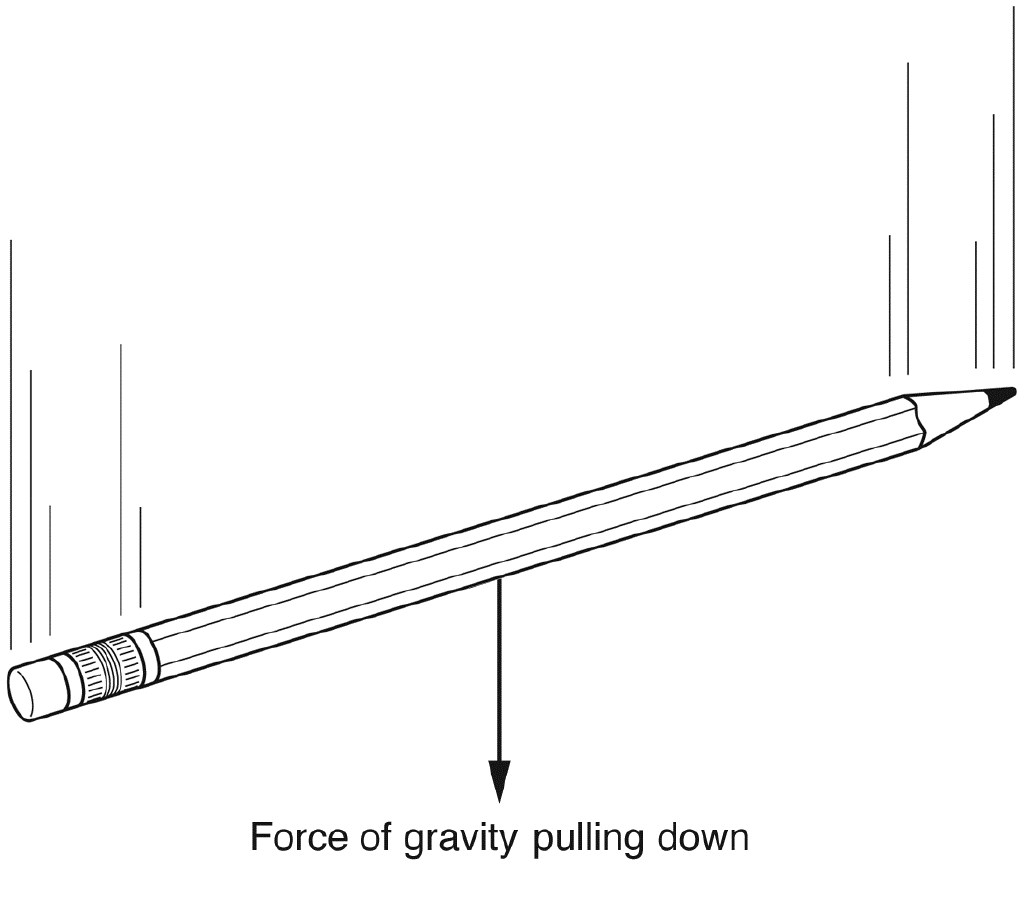
Consider what happens to another object—say a box resting on the floor—when you exert a force on it by pushing it. If the box is initially at rest, it begins to move and gains velocity. When the box goes from not moving to moving, its velocity changes. When any object goes from not moving to moving, physicists say it accelerates. In other words, the object’s velocity changes; it goes from having no velocity to having some velocity. Therefore, it can be said that acceleration is the change in velocity.
STEM Words to Know
velocity
Velocity is a measurement of both the speed of an object and the direction it is moving in. A moving object has velocity. A nonmoving object has no velocity. When a car is moving at 60 mph, that number is referring to how fast the car is moving, or the car’s speed. However, when you say the car is moving at 60 mph heading north, you are reporting both how fast as well as the direction the car is moving. You are reporting velocity.
Sometimes people confuse the concept of velocity with the concept of momentum. Velocity of an object has to do with how fast it’s moving. Momentum is related not only to how fast the object is moving, but also to how massive the object is. A truck moving at 60 mph has a lot more momentum than a car moving at 60 mph because the truck has a greater mass. Just be aware that velocity and momentum are not the same concepts.
What caused the box, or the pencil, to accelerate? According to Newton’s second law, the force of the push (on the box), or the force of gravity (on the pencil) causes the object to change its velocity, or to accelerate.
A simple experiment will shed light on the reason feathers sway or seem to float as they fall toward the ground, while objects like pencils don’t. Instead of using feathers, you can use something easier to find around the house.
Materials Needed:
- 2 sheets of 81⁄2" × 11" paper
Procedure:
- Give your child one of the sheets of paper. Have him hold it horizontally about 4 feet above the ground, then let go. Observe how the flat sheet of paper sways, or appears to float, as it falls toward the ground.
- Now take the other sheet of paper, have him crumple it into the tiniest ball he can, hold it about 4 feet above the ground, and let go. What did you both observe?
Did the crumpled sheet of paper fall to the ground in the same manner as the flat sheet? Why do you suppose they behaved differently, even though they’re made of the same material (paper)?
Here’s a hint: Ask your child what the difference is between the flat sheet and the crumpled sheet of paper. Remind him that they were identical to start with, and they’re both made of the same material. Do you think it matters that the flat sheet has a larger surface than the crumpled one?
If he answered yes to that last question, he’s absolutely right. It does indeed matter that the flat sheet has a larger surface than the crumpled sheet. The crumpled sheet of paper falls straight to the ground—no sway whatsoever. The flat sheet, with its larger surface area, sways or “floats” as it’s falling to the ground.
Take a few moments to consider and discuss the forces influencing the flat sheet as it falls. It’s already been established that the force of gravity pulls the sheet down. However, while the sheet is falling through the air, another force comes into play. This other force is the force of the air that pushes upward against every part of the paper’s surface. It’s the very same force that pushes up on a skydiver’s parachute. If the surface of the flat sheet is larger, the air can push up more. This force that involves the air pushing upwardly is called air resistance.
If you look at the two forces acting on the sheet of paper (shown in the following diagram), you’ll notice that the two forces are acting in opposite directions.
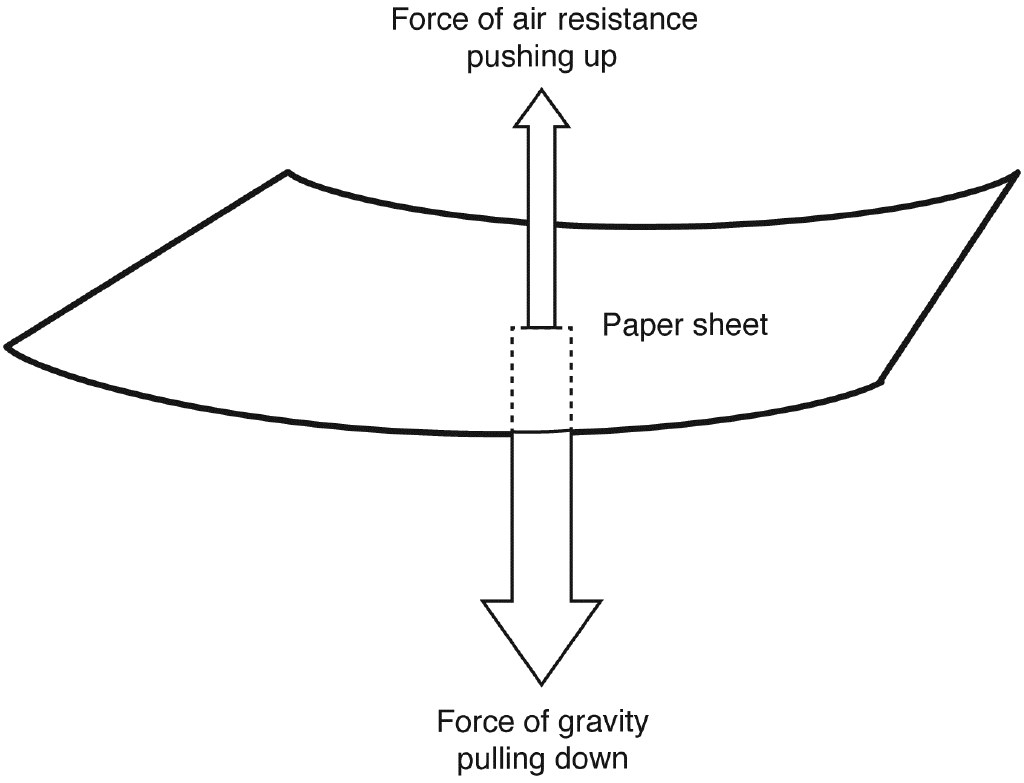
When you’re playing tug of war, if one team pulls slightly harder than the other, that team will make everyone begin to move in their direction slowly. It’s exactly the same with the two opposite forces of gravity and air resistance. When the force of gravity is slightly bigger than the force of air resistance, the object’s velocity changes in the direction of the bigger force slowly—that is, the flat sheet sways, or seems to float, as it falls to the ground. The same principle applies to a falling feather.
STEM Q&A
Q: How does Newton’s second law work if there is more than one force?
A: In tug of war, the object getting pulled is the rope. It’s being pulled to the right and to the left at the same time, so it is experiencing two opposite forces. If the rope is pulled with equal forces from both sides, it doesn’t move. But if one team—say the team on the right—pulls slightly harder, then there is a difference between the two pulls. The difference between the two opposing forces is small and points in the favor of the direction of the bigger force (to the right). That difference is what causes the team on the right to begin accelerating—to change their velocity from not moving to moving. The bigger the difference between the two opposing forces, the bigger the acceleration and the faster the change in velocity.
When you crumple the sheet of paper, the surface area the air can push against becomes smaller, reducing the force of air resistance. With the crumpled sheet, the force of gravity is much bigger than the force of air resistance, and it will pull harder, making the crumpled paper fall to the ground faster. This is also why a pencil falls straight to the ground when it’s dropped instead of swaying or floating like a feather.
STEM Career Choices
Seismologist
Seismologists are considered earth scientists. They study seismic waves that propagate through geological material. This material includes the interior of our planet all the way to the core, as well as the surface crust.
Through analyzing data from earthquakes, seismologists are able to infer the structure of our planet’s interior. Seismologists may also advise companies that are exploring for oil. (Digging for petroleum often involves explosions that cause seismic waves.) Seismologists also work with engineers to assess methods to minimize damage from earthquakes to buildings and other manmade structures. This allows for construction standards to be improved.
ACTIVITY: What’s in Soil?
If you’ve looked at dirt across the landscape in many places, you’ve probably noticed that dirt comes in many colors. Soil can have a strong brown color, or a dark gray, reddish yellow, red, or even black color. The different colors of soil tell an expert soil scientist about the chemical composition of that soil. Let’s explore some basic interpretations about soil color, and see what chemical elements in the soil are responsible for those dominant colors.
Materials Needed:
- Notebook to record observations
- Pen
Procedure:
- Go outside into your backyard or drive to a park where you can directly observe soil that’s not covered with grass or other landscaping material such as mulch or rocks. If there is greenery or other cover that prevents you from seeing the soil, you can dig out some of the dirt to view it.
- Once you’ve accessed the soil and you’re able to observe it, ask your child what color the soil is. It might be easier to give your child a list of possible colors to help her make the distinction. Ask her if the soil is dark, light, or red.
- Tell your child to record her observations in her notebook.
- Drive to a garden nursery where they sell plants and dirt for your garden. This is a good place to look at different color dirt that might be available at your local nursery. Once you arrive, ask your child to observe the color of the dirt in the piles available. Have her record those colors in her notebook.
- If you live in or near the countryside, drive around in early spring or late fall and observe the soil colors in those fields. Have your child record those soil colors as well.
- Finally, if you have access to hiking trails with natural surroundings, take your child for a hike and have her take her notebook along with her. Ask your child if she notices new colors in the soil on the sides of the trail. Ask her to record those colors.
STEM Career Choices
Soil Scientist
Soil scientists evaluate soils. They are able to analyze data related to soil in order to understand the resources present in soil. This is especially important for agricultural purposes since soil is a natural resource. Some of the activities soil scientists engage in include evaluating forest soils and wetlands. They should also be able to investigate soil that would be used for waste, including the disposal of residential waste.
A soil scientist is knowledgeable about the soil’s chemistry, physics, and biology. For example, a soil scientist is able to study the stability of the soil, its ability to drain or retain moisture, and its sustainability and impact on the environment.
Now it’s time for your child to examine her observations. Did your child discover several colors to the different soils she observed? Assist her with learning the interpretation of the different colors of soil she observed. Soil that is light in color or looks whitish is rich in calcium and magnesium carbonates, or some other salts:
- Calcium is one of the chemical elements in the periodic table of the elements, which lists all elements known to us in the universe. Calcium is grouped with alkaline earth metals, and it has a soft gray color in appearance. Calcium is an important element for living organisms, and it is essential for the mineralization process of teeth, bone, and shells.
- Calcium Carbonate is a chemical compound that has calcium and carbon. It also has oxygen. It’s white in color, and it’s known by other names, such as limestone. It’s a main component in rocks, shells, pearls, and even eggs.
- Magnesium Carbonate is a chemical compound that has magnesium and carbon, as well as oxygen. It’s also white in color. Like calcium, magnesium is an element in the periodic table. It’s also grouped with alkaline earth metals, but has a shiny gray color. Magnesium carbonate is found, for example, in natural unrefined salt, such as Himalayan salt.
If the soil is dark or black, there’s a lot of organic matter in it such as the breakdown of residual plants. Sometimes the dark soil points to the presence of charcoal in it. Red soil indicates the presence of iron in it. When iron oxidizes it becomes red, forming iron oxides (such as rust).
STEM Words to Know
iron
Iron is one of the elements in the periodic table that is considered a metal. It is the fourth most common element in the crust of planet Earth. It is also present in abundance in Earth’s core and plays a role in Earth’s magnetic field that make a compass needle always point north.
If you and your child encounter soil of other colors besides the ones listed above, then have her do a search online for the chemical composition of that soil color.
STEM Career Choices
Oceanographer
Oceanographers deal with many disciplines, including marine life, ocean circulation, ecosystems, ocean floors, and plate tectonics. There are many specialties within the field such as biological, chemical, physical, and geological oceanography. Biological oceanographers study plants, animals, and organisms that live in the marine environment. They engage in field observations and experiments as well as lab experiments. A chemical oceanographer studies the ocean water, its composition and cycles, and its interaction with the seafloor as well as the atmosphere.
Physical oceanographers study physical processes in the ocean, such as waves and currents, the transport of sand to and from shores, and the erosion of coastlines. A geological oceanographer studies the ocean floor—its mountains, valleys, and ridges.